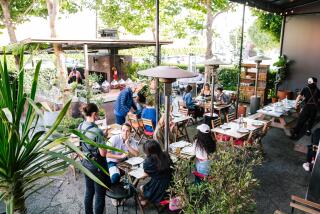New-Style Persian, Centuries-Old Tradition Meet in Paradise
- Share via
Ferdussi is a new-style Persian restaurant, but under the surface there are 50 centuries of culture.
It’s clear from the outset that owner Seyed Miremadi, who also runs the very fine Alborz in Laguna Niguel, sees Ferdussi as a sort of Garden of Eden (the name comes from the Farsi word for “paradise”--which originally meant an enclosed garden). His sumptuously embossed menu is emblazoned with cuneiform writing, a depiction of a silver plate from the 3rd Century and a mini-history of Persian food and culture. The restaurant’s decor is downright rococo, reminiscent of the parlor chamber where Keir Dullea’s character found himself just before being transformed into a space child in “2001: A Space Odyssey.”
The one paradox is that the food here is, in essence, hardly different from that found in other local Persian restaurants, aside from being a tad more pricey. When reached by phone, Miremadi indicated that he would be serving quail, sturgeon and a few rare Persian dishes, things that would “change everyone’s mind about Persian cuisine.”
But so far, Ferdussi’s menu, other than being more handsomely produced than any of its rivals, is a virtual clone of other local Persian menus: the same basic appetizers, the same kebabs, the same core pilafs. On three separate occasions the vaunted sturgeon was unavailable, the quail nonexistent and the specials only a figment of the imagination. When asked why, Miremadi explained that he simply needs more time to develop his ideas in the kitchen.
That doesn’t mean you shouldn’t come right now, though.
Ferdussi is a lovely place, really--wildly spacious, with an Op Art carpet, brass chandeliers, potted plants and a pastel-green soffit smack in the middle of the ceiling. The very best seats are the red-upholstered booths along the walls.
And on those walls are educational photos of Persian art and architecture. Here is a Zoroastrian fire temple; over there is the tiled dome of Gur-e Amir, Tamerlane’s colossal tomb in Samarkand. Miremadi has spared no expense to bring us an elegant shrine to his native cuisine, and that is why we expect more of it.
But after your order is taken by Miremadi’s eloquent and solicitous young team of servers, things fall into a familiar pattern. You begin a meal here with the usual basket piled up with flat squares of the Persian bread called lavash, accompanied by a whole onion and some wrapped pats of butter. Then a parade of filling dishes begins.
The best way to sample the appetizers is to order Ferdussi’s combination platter, a bargain at only $8.95. This price allows you to pick any three appetizers from a long list of Persian favorites, all of which are served in separate dishes.
Some of my favorites are panir sabzi , two large bricks of creamy feta, a heap of shelled walnuts, some radishes and a colorful pile of fresh herbs (mint, cilantro, basil, tarragon); kashk bademjan , a sauteed eggplant puree drenched with dried thickened yogurt; and something called shekam pareh , a slightly oily but tasty halved eggplant stuffed with ground meat. The grape leaves called dolmeh and the various yogurt preparations are other strong possibilities.
Dinners are served with either salad or soup, but take note that Persian soups can be extremely filling. Jow is a hearty stock of barley, beef, vegetables and Persian spices. Ash reshtesh is more complex--full of pinto beans, spinach, kashk, onions and strange squiggly noodles, all combined with a strong sprinkling of fresh mint.
Ferdussi has a long list of kebabs, too, most of which come with a small mountain of fluffy basmati rice. The tender, tasty whitefish kebab is served, as at Alborz, with the dill-sprinkled rice and lima bean specialty called baghala polo .
The best of the meat kebabs is probably a meltingly soft lamb chop kebab: three chops with a gamy, meaty taste. The least interesting is surely chicken kubideh , two cylinders of ground chicken with all the flavor of food at a fat farm.
You can also choose from entrees such as adas polo, zereshk polo, gheimeh and fesenjon , if your taste runs to more exotic thresholds. Adas polo is the sweeter of the two pilafs, the fluffy rice chock-full of yellow lentils, raisins, whole dates and saffron, covering a massive piece of slowly simmered chicken. Zereshk is a Persian word for the barberry, which is like a tart, intense little currant with a medicinal undertaste. Zereshk polo also hides chicken, but the presence of sauteed onion gives it an entirely different character.
Gheimeh is, for the uninitiated at least, an acquired taste. The dish consists of chunks of beef, yellow split peas and an herbal tomato sauce that my dining companions generally find odd. Fesenjan , though, is something that overwhelms even the least experienced palate. It’s basically chicken simmered in a purple pomegranate sauce thickened with a walnut paste. In restaurants, this dish tends to be cloying, but Ferdussi makes a powerful, grainy, complex version that would sate an elephant.
When you enter, notice the glass dome at the bar, the one filled with Persian sweets. You’re looking at bamyeh (the ones shaped like little cookies), zulbia (bubbly coils of fried dough) and baklava. All of these desserts are strongly perfumed with rosewater and, to my mind, rather one-dimensional, but to some, no doubt, they are paradise.
Ferdussi is moderately priced. Appetizers are $2.95 to $8.95. Entrees are $7.95 to $11.95.
* FERDUSSI
* 3605 S. Bristol St., Suite D, Santa Ana.
* (714) 545-9096.
* Open Sunday through Thursday, 11:30 a.m. to 10:30 p.m., Friday till 1 a.m. and Saturday till 4 a.m.
* American Express, MasterCard and Visa accepted.
More to Read
Eat your way across L.A.
Get our weekly Tasting Notes newsletter for reviews, news and more.
You may occasionally receive promotional content from the Los Angeles Times.










